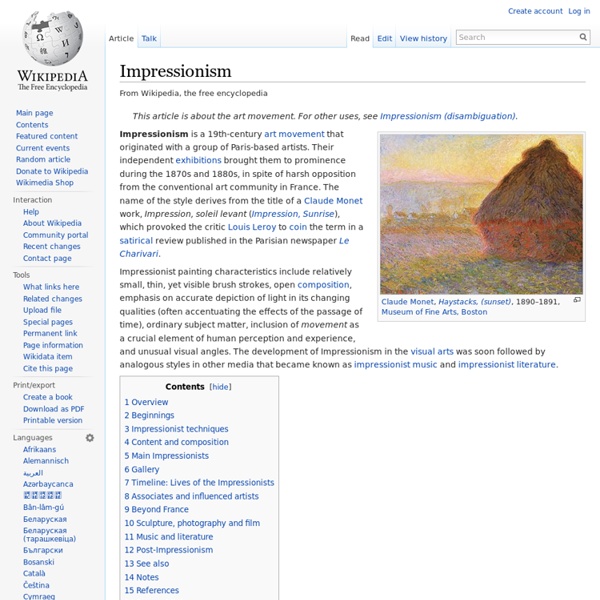Pre-Raphaelite Brotherhood
The Pre-Raphaelite Brotherhood (also known as the Pre-Raphaelites) was a group of English painters, poets, and critics, founded in 1848 by William Holman Hunt, John Everett Millais and Dante Gabriel Rossetti. The three founders were joined by William Michael Rossetti, James Collinson, Frederic George Stephens and Thomas Woolner to form the seven-member "brotherhood". The group's intention was to reform art by rejecting what it considered the mechanistic approach first adopted by Mannerist artists who succeeded Raphael and Michelangelo. Its members believed the Classical poses and elegant compositions of Raphael in particular had been a corrupting influence on the academic teaching of art, hence the name "Pre-Raphaelite". In particular, the group objected to the influence of Sir Joshua Reynolds, founder of the English Royal Academy of Arts, whom they called "Sir Sloshua". Beginnings[edit] Illustration by Holman Hunt of Thomas Woolner's poem "My Beautiful Lady", published in The Germ, 1850
Impressionism
Impressionism Movement, Artists and Major Works | The Art Story
"Impressionism is only direct sensation. All great painters were less or more impressionists. It is mainly a question of instinct." Impressionism can be considered the first distinctly modern movement in painting. Developing in Paris in the 1860s, its influence spread throughout Europe and eventually the United States. Its originators were artists who rejected the official, government-sanctioned exhibitions, or salons, and were consequently shunned by powerful academic art institutions. Impressionism was a style of representational art that did not necessarily rely on realistic depictions. The Impressionists loosened their brushwork and lightened their palettes to include pure, intense colors. Subscribe to Share on Facebook Share on Twitter Welcome to The Art Story! Error occured while saving data... Like The Art Story Foundation on Facebook Impressionism Beginnings Exhibitions in Paris and The Salon des Refusés Salon des Artistes Indépendants Édouard Manet and the Painting Revolution
Industrial Revolution
Iron and Coal, 1855–60, by William Bell Scott illustrates the central place of coal and iron working in the industrial revolution and the heavy engineering projects they made possible. The Industrial Revolution was the transition to new manufacturing processes in the period from about 1760 to sometime between 1820 and 1840. This transition included going from hand production methods to machines, new chemical manufacturing and iron production processes, improved efficiency of water power, the increasing use of steam power, and the development of machine tools. The Industrial Revolution marks a major turning point in history; almost every aspect of daily life was influenced in some way. Etymology Some historians, such as John Clapham and Nicholas Crafts, have argued that the economic and social changes occurred gradually and the term revolution is a misnomer. Important technological developments Textile manufacture Watch video: Demonstration of fly shuttle on YouTube Steam power Machine tools
Mark Harden's Artchive: "Impressionism"
Impressionism Send email to The Artchive [Art Posters][Home][Juxtapositions][Galleries][Theory and Criticism][Art CD-ROM Reviews][Artchive][Links]
Claude Monet, Impression, soleil levant
Special relativity
Special relativity implies a wide range of consequences, which have been experimentally verified,[2] including length contraction, time dilation, relativistic mass, mass–energy equivalence, a universal speed limit, and relativity of simultaneity. It has replaced the conventional notion of an absolute universal time with the notion of a time that is dependent on reference frame and spatial position. Rather than an invariant time interval between two events, there is an invariant spacetime interval. A defining feature of special relativity is the replacement of the Galilean transformations of classical mechanics with the Lorentz transformations. The theory is called "special" because it applied the principle of relativity only to the special case of inertial reference frames. Galileo Galilei had already postulated that there is no absolute and well-defined state of rest (no privileged reference frames), a principle now called Galileo's principle of relativity. Postulates[edit] where we get
Cubism
A primary influence that led to Cubism was the representation of three-dimensional form in the late works of Paul Cézanne, which were displayed in a retrospective at the 1907 Salon d'Automne.[3] In Cubist artwork, objects are analyzed, broken up and reassembled in an abstracted form—instead of depicting objects from one viewpoint, the artist depicts the subject from a multitude of viewpoints to represent the subject in a greater context.[4] Conception and origins[edit] Pablo Picasso, 1909-10, Figure dans un Fauteuil (Seated Nude, Femme nue assise), oil on canvas, 92.1 x 73 cm, Tate Modern, London Cubism began between 1907 and 1911. Pablo Picasso's 1907 painting Les Demoiselles d'Avignon has often been considered a proto-Cubist work. Georges Braque's 1908 Houses at L’Estaque (and related works) prompted the critic Louis Vauxcelles to refer to bizarreries cubiques (cubic oddities). John Berger identifies the essence of Cubism with the mechanical diagram. "M. Cubism before 1914[edit]
Sigmund Freud
Sigmund Freud (/frɔɪd/;[2] German pronunciation: [ˈziːkmʊnt ˈfʁɔʏ̯t]; born Sigismund Schlomo Freud; 6 May 1856 – 23 September 1939) was an Austrian neurologist, now known as the father of psychoanalysis. Freud qualified as a doctor of medicine at the University of Vienna in 1881,[3] and then carried out research into cerebral palsy, aphasia and microscopic neuroanatomy at the Vienna General Hospital.[4] Upon completing his habilitation in 1895, he was appointed a docent in neuropathology in the same year and became an affiliated professor (professor extraordinarius) in 1902.[5][6] Psychoanalysis remains influential within psychotherapy, within some areas of psychiatry, and across the humanities. As such, it continues to generate extensive and highly contested debate with regard to its therapeutic efficacy, its scientific status, and whether it advances or is detrimental to the feminist cause.[10] Nonetheless, Freud's work has suffused contemporary Western thought and popular culture.



